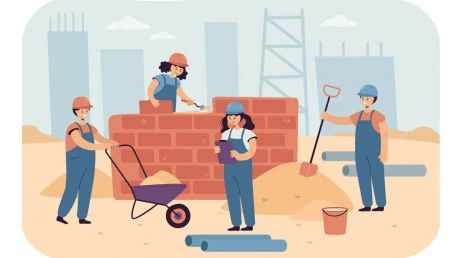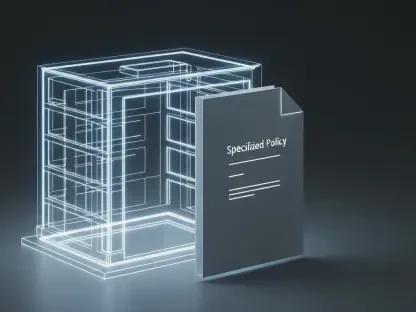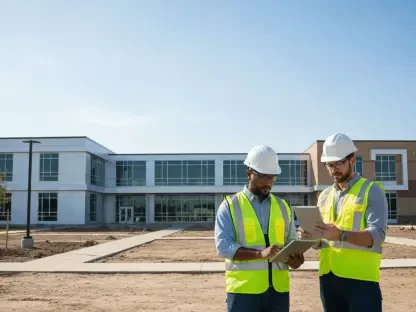The construction sector stands on the cusp of a technological revolution powered by artificial intelligence (AI). No longer the stuff of science fiction, AI is quickly becoming an integral part of the modern construction site, promising to enhance efficiencies, tackle complex challenges, and rejuvenate the workforce. This burgeoning integration raises vital questions and necessitates strategic planning to ensure that AI serves as a workforce enabler rather than a disruptor. As construction companies navigate this shift, the core focus remains not just on embracing AI but on capitalizing on its synergies with human skills to redefine the construction landscape.
The Emergence of AI in Construction
Artificial intelligence is carving out a significant presence in the construction industry, transforming the way projects are planned, managed, and executed. This growth is driven by a multitude of factors, from the pressing need to improve project delivery timelines to the ever-increasing complexity of construction projects. Progressive industry leaders view AI as an inherent extension of their teams, capable of processing vast amounts of data to make predictive analyses and streamline operations. Efficiencies are being unlocked at every turn, and complex constructions are benefiting from AI-driven insights that were once beyond human computation speed and accuracy.The perception of AI within the industry is undergoing a sea change as proponents advocate its adoption. In essence, AI in construction is not being framed as a novel gadget but rather as the evolution of the toolbox, an indispensable element that bolsters the existing human workforce.
AI: Job Creator or Job Stealer?
As AI’s role in construction becomes more pronounced, concerns surrounding the potential impact on employment have surfaced. Fears that AI might render human workers obsolete are balanced by a more nuanced understanding wherein AI is seen as transforming job roles rather than annihilating them. Experts argue that AI enables a more sophisticated division of labor, where routine and repetitive tasks are automated, allowing human workers to focus on high-value, complex activities that necessitate human judgment and creativity.The discourse around AI in construction increasingly leans towards the evolution, not eradication, of jobs. By shouldering the burden of routine tasks, AI opens up avenues for human workers to engage more deeply with strategic objectives, including the pursuit of sustainable development goals and other critical industry milestones.
Navigating AI Integration in Construction Workflows
Integrating AI into construction operations is not without its challenges. It demands clear objectives and a rigorous approach to selecting, training, and guiding AI systems, much like nurturing a human trainee. Construction firms face decisions on whether to build bespoke AI systems tailored to specific tasks or to adopt off-the-shelf solutions with broader applications. The success of AI implementation hinges critically on ensuring that these digital tools align seamlessly with existing workflows and enhance, rather than complicate, existing processes.For successful AI adoption, construction companies must not only address technological compatibility but also the readiness of their workforce to interact and grow with AI. The focus should be on symbiotic relationships, leveraging AI’s capabilities to augment humans’ skills, not replace them.
Balancing Innovation and Governance of AI
Regulatory frameworks and standards such as the EU’s Artificial Intelligence Act and ISO 42001 underscore the need for governance in AI’s deployment within the construction sector. These regulations and best practices aim to mitigate risks, ensuring that AI applications are ethical, transparent, and secure. As the development of AI tools accelerates, the industry must keep pace, ensuring AI usage aligns with these evolving guidelines.Safe and ethical AI implementation is essential—as is navigating the tension between innovation and regulation. Industry stakeholders must collaborate to foster environments where innovative AI solutions can thrive without compromising safety and privacy, encouraging a responsible trajectory for AI integration within construction.
Data Management Challenges and Opportunities
Dealing with unstructured data is one of the main hurdles in fully leveraging AI within the construction industry. These datasets, when properly organized and interpreted by AI systems, can offer profound insights into project planning, risk management, and operational efficiency. AI’s proficiency in managing and making sense of unstructured information can unearth hidden patterns and streamline decision-making processes.The reluctance to share proprietary data within the construction industry adds a layer of complexity when trying to enhance AI capabilities. Overcoming this hesitation is crucial for AI to realize its full potential, which relies on access to comprehensive datasets. Encouraging data sharing, while safeguarding sensitive information, is a balance that must be struck to propel the industry forward.
Adapting to a Generational Workforce Shift
AI’s transformative power in the construction industry may also play a pivotal role in addressing the generational shift within its workforce. As experienced professionals retire, AI can serve as an attractant for digital-savvy newcomers while ensuring knowledge continuity. The veteran workforce is liberated from monotonous tasks to mentor younger colleagues and engage in more intricate project work, which benefits from their expertise.Intergenerational collaboration, strengthened by AI, can foster a dynamic workforce where seasoned professionals and new entrants leverage each other’s strengths. This not only ensures a richer transfer of knowledge but also crafts a future-ready industry competent in both traditional and cutting-edge construction techniques.
AI as a Collaborative Partner in Construction
The consensus amongst industry veterans is that AI is to be viewed as a collaborator, not a competitor. Seen through this lens, AI becomes a vital partner that amplifies human capability, creativity, and strategic planning. It serves as a keystone technology that streamlines complex processes and equips the construction workforce to tackle projects of increasing complexity and scale.AI is redefining the collaboration paradigm in construction, positioning itself as a force multiplier rather than a replacement for human input. This partnership promises a more efficient, innovative, and responsive construction industry, capable of overcoming contemporary challenges and shaping the built environment of the future.
Upskilling and Strategy Development
Artificial intelligence (AI) is swiftly transforming the construction industry, becoming a key component on job sites. It’s no fantasy—AI improves efficiency, solves intricate problems, and invigorates the workforce. The impact of AI is profound, acting more like a collaborator than a replacement for human workers.The revolution of AI in construction involves strategic implementation to ensure it augments workforce capabilities. Firms are not just adopting AI technologies—they’re strategically integrating them to enhance the way workers perform tasks. The promise lies not simply in the adoption of AI, but in its combination with human expertise. This approach reimagines construction practices, leading to smarter project management and more agile decision-making.AI’s potential in construction stretches from predictive analytics for project planning to robotics for automated processes. But the goal is clear: maximizing the harmonious relationship between AI and human intelligence, thus driving the sector towards unprecedented efficiency and productivity. As we stand at this technological frontier, the construction sector’s priorities involve responsibly harnessing AI’s benefits while preparing its workforce for a transformed future. The task ahead is to ensure that AI’s integration not only propels the industry forward but also empowers its most valuable asset—its people.









